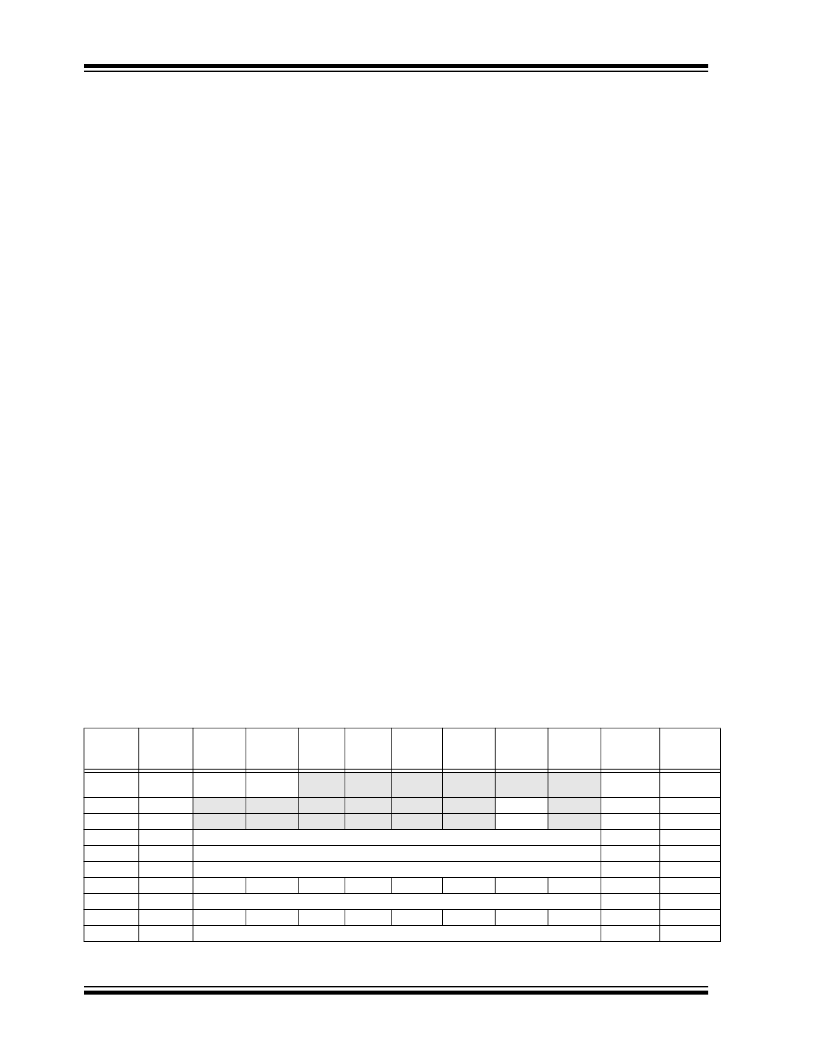- 您現(xiàn)在的位置:買賣IC網(wǎng) > PDF目錄368024 > PIC16C717 (Microchip Technology Inc.) 8-Bit CMOS Microcontrollers(8位CMOS微控制器) PDF資料下載
參數(shù)資料
| 型號: | PIC16C717 |
| 廠商: | Microchip Technology Inc. |
| 英文描述: | 8-Bit CMOS Microcontrollers(8位CMOS微控制器) |
| 中文描述: | 8位CMOS微控制器(8位的CMOS微控制器) |
| 文件頁數(shù): | 66/220頁 |
| 文件大小: | 3585K |
| 代理商: | PIC16C717 |
第1頁第2頁第3頁第4頁第5頁第6頁第7頁第8頁第9頁第10頁第11頁第12頁第13頁第14頁第15頁第16頁第17頁第18頁第19頁第20頁第21頁第22頁第23頁第24頁第25頁第26頁第27頁第28頁第29頁第30頁第31頁第32頁第33頁第34頁第35頁第36頁第37頁第38頁第39頁第40頁第41頁第42頁第43頁第44頁第45頁第46頁第47頁第48頁第49頁第50頁第51頁第52頁第53頁第54頁第55頁第56頁第57頁第58頁第59頁第60頁第61頁第62頁第63頁第64頁第65頁當前第66頁第67頁第68頁第69頁第70頁第71頁第72頁第73頁第74頁第75頁第76頁第77頁第78頁第79頁第80頁第81頁第82頁第83頁第84頁第85頁第86頁第87頁第88頁第89頁第90頁第91頁第92頁第93頁第94頁第95頁第96頁第97頁第98頁第99頁第100頁第101頁第102頁第103頁第104頁第105頁第106頁第107頁第108頁第109頁第110頁第111頁第112頁第113頁第114頁第115頁第116頁第117頁第118頁第119頁第120頁第121頁第122頁第123頁第124頁第125頁第126頁第127頁第128頁第129頁第130頁第131頁第132頁第133頁第134頁第135頁第136頁第137頁第138頁第139頁第140頁第141頁第142頁第143頁第144頁第145頁第146頁第147頁第148頁第149頁第150頁第151頁第152頁第153頁第154頁第155頁第156頁第157頁第158頁第159頁第160頁第161頁第162頁第163頁第164頁第165頁第166頁第167頁第168頁第169頁第170頁第171頁第172頁第173頁第174頁第175頁第176頁第177頁第178頁第179頁第180頁第181頁第182頁第183頁第184頁第185頁第186頁第187頁第188頁第189頁第190頁第191頁第192頁第193頁第194頁第195頁第196頁第197頁第198頁第199頁第200頁第201頁第202頁第203頁第204頁第205頁第206頁第207頁第208頁第209頁第210頁第211頁第212頁第213頁第214頁第215頁第216頁第217頁第218頁第219頁第220頁

PIC16C717/770/771
DS41120B-page 64
2002 Microchip Technology Inc.
8.3.7
SYSTEM IMPLEMENTATION
When the ECCP module is used in the PWM mode, the
application hardware must use the proper external pull-
up and/or pull-down resistors on the PWM output pins.
When the microcontroller powers up, all of the I/O pins
are in the high-impedance state. The external pull-up
and pull-down resistors must keep the power switch
devices in the off state until the microcontroller drives
the I/O pins with the proper signal levels, or activates
the PWM output(s).
8.3.8
START-UP CONSIDERATIONS
Prior to enabling the PWM outputs, the P1A, P1B, P1C
and P1D latches may not be in the proper states.
Enabling the TRISB bits for output at the same time
with the CCP module may cause damage to the power
switch devices. The CCP1 module must be enabled in
the proper Output mode with the TRISB bits enabled as
inputs. Once the CCP1 completes a full PWM cycle,
the P1A, P1B, P1C and P1D output latches are prop-
erly initialized. At this time, the TRISB bits can be
enabled for outputs to start driving the power switch
devices. The completion of a full PWM cycle is indi-
cated by the TMR2IF bit going from a
’
0
’
to a
’
1
’
.
8.3.9
SET UP FOR PWM OPERATION
The following steps should be taken when configuring
the ECCP module for PWM operation:
1.
Configure the PWM module:
a)
Disable the CCP1/P1A, P1B, P1C and/or
P1D outputs by setting the respective
TRISB bits.
b)
Set the PWM period by loading the PR2
register.
c)
Set the PWM duty cycle by loading the
CCPR1L register and CCP1CON<5:4>
bits.
d)
Configure the ECCP module for the desired
PWM operation by loading the CCP1CON
register. With the CCP1M<3:0> bits select
the active high/low levels for each PWM
output. With the PWM1M<1:0> bits select
one of the available Output modes: Single,
Half-Bridge, Full-Bridge, Forward or Full-
Bridge Reverse.
e)
For Half-Bridge Output mode, set the dead-
band delay by loading the P1DEL register.
2.
Configure and start TMR2:
a)
Clear the TMR2 interrupt flag bit by clearing
the TMR2IF bit in the PIR1 register.
b)
Set the TMR2 prescale value by loading the
T2CKPS<1:0> bits in the T2CON register.
c)
Enable Timer2 by setting the TMR2ON bit
in the T2CON register.
3.
Enable PWM outputs after a new cycle has
started:
a)
Wait until TMR2 overflows (TMR2IF bit
becomes a
’
1
’
). The new PWM cycle begins
here.
b)
Enable the CCP1/P1A, P1B, P1C and/or
P1D pin outputs by clearing the respective
TRISB bits.
TABLE 8-3:
REGISTERS ASSOCIATED WITH PWM
Address
Name
Bit 7
Bit 6
Bit 5
Bit 4
Bit 3
Bit 2
Bit 1
Bit 0
Value on
POR,
BOR
Value on
all other
RESETS
0Bh, 8Bh,
GIE
PEIE
T0IE
INTE
RBIE
T0IF
INTF
RBIF
0000 000x
0000 000u
0Ch
PIR1
—
ADIF
—
—
SSPIF
CCP1IF
TMR2IF
TMR1IF
-0-- 0000
-0-- 0000
8Ch
PIE1
—
ADIE
—
—
SSPIE
CCP1IE
TMR2IE
TMR1IE
-0-- 0000
-0-- 0000
86h, 186h
TRISB
PORTB Data Direction Register
1111 1111
1111 1111
11h
TMR2
Timer2 register
0000 0000
0000 0000
92h
PR2
Timer2 period register
1111 1111
1111 1111
12h
T2CON
—
TOUTPS3 TOUTPS2 TOUTPS1 TOUTPS0
TMR2ON
T2CKPS1
T2CKPS0
-000 0000
-000 0000
15h
CCPR1L
Capture/Compare/PWM register1 (LSB)
xxxx xxxx
uuuu uuuu
17h
CCP1CON PWM1M1
PWM1M0
DC1B1
DC1B0
CCP1M3
CCP1M2
CCP1M1
CCP1M0
0000 0000
0000 0000
97h
Legend:
P1DEL
PWM1 Delay value
0000 0000
0000 0000
x = unknown, u = unchanged, - = unimplemented read as '0'. Shaded cells are not used by ECCP module in PWM mode.
相關PDF資料 |
PDF描述 |
|---|---|
| PIC16C770 | 8-Bit CMOS Microcontrollers(8位CMOS微控制器) |
| PIC16C771 | 8-Bit CMOS Microcontrollers(8位CMOS微控制器) |
| PIC16C73A | 8-Bit CMOS Microcontrollers with A/D Converter |
| PIC16C76 | 8-Bit CMOS Microcontrollers with A/D Converter(每個I/O口有25mA驅動/吸收電流,并行從動口,2路捕捉/比較/PWM的微控制器) |
| PIC16C77 | 8-Bit CMOS Microcontrollers with A/D Converter(每個I/O口有25mA驅動/吸收電流,并行從動口,1路捕捉/比較/PWM的微控制器) |
相關代理商/技術參數(shù) |
參數(shù)描述 |
|---|---|
| PIC16C717/JW | 功能描述:8位微控制器 -MCU 3.5KB 256 RAM 16 I/O RoHS:否 制造商:Silicon Labs 核心:8051 處理器系列:C8051F39x 數(shù)據(jù)總線寬度:8 bit 最大時鐘頻率:50 MHz 程序存儲器大小:16 KB 數(shù)據(jù) RAM 大小:1 KB 片上 ADC:Yes 工作電源電壓:1.8 V to 3.6 V 工作溫度范圍:- 40 C to + 105 C 封裝 / 箱體:QFN-20 安裝風格:SMD/SMT |
| PIC16C717/P | 功能描述:8位微控制器 -MCU 3.5KB 256 RAM 16 I/O RoHS:否 制造商:Silicon Labs 核心:8051 處理器系列:C8051F39x 數(shù)據(jù)總線寬度:8 bit 最大時鐘頻率:50 MHz 程序存儲器大小:16 KB 數(shù)據(jù) RAM 大小:1 KB 片上 ADC:Yes 工作電源電壓:1.8 V to 3.6 V 工作溫度范圍:- 40 C to + 105 C 封裝 / 箱體:QFN-20 安裝風格:SMD/SMT |
| PIC16C717/P | 制造商:Microchip Technology Inc 功能描述:IC 8BIT CMOS MCU 16C717 DIP18 |
| PIC16C717/P | 制造商:Microchip Technology Inc 功能描述:Microcontroller IC Number of I/Os:16 |
| PIC16C717/PC01 | 制造商:Microchip Technology Inc 功能描述: |
發(fā)布緊急采購,3分鐘左右您將得到回復。